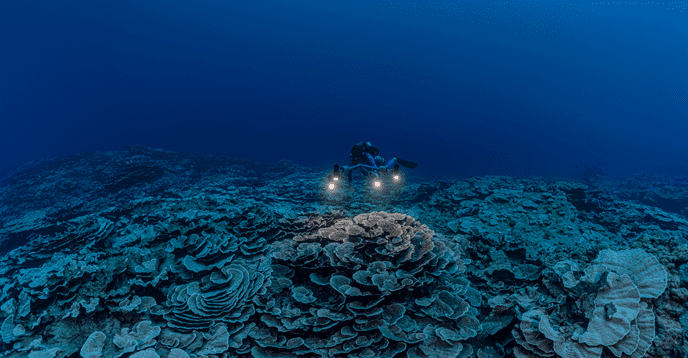UNESCO scuba divers have discovered a new coral reef in the depths of Tahiti’s coastline.

Most of the news regarding coral reefs we’ve heard recently revolves around bleachings — deadly events that take place when waters get too hot for corals to survive. Amid this backdrop, we get a rare piece of good news: divers from the United Nations Educational, Scientific and Cultural Organization (UNESCO) report discovering a new, massive reef off the coast of Tahiti, the largest island in French Polynesia, South Pacific.
The reef is composed of rose-shaped corals, untouched by humans so far, and in surprisingly good health given the global plight of coral reefs.
New reefs
The reef, which remains unnamed so far, measures around 1.9 miles (3 kilometers) in length and between 98 to 213 feet (30 to 65 meters) across. It formed at a depth of between 100 and 180 feet (31 to 55 meters), unusually deep for a coral reef in the tropics; they are usually found in shallow water, less than 82 feet (25 meters) from the surface.
Researchers believe that this depth helped insulate the reef from the brunt of climate-change-induced effects.
An encrusting plate coral species, Pachyseris speciosa, is the main dweller of the reef. It forms rose-like groupings that can reach up to 6.5 feet (2 meters) wide. The reef was discovered by seafloor explorers of the Ocean 1 project in November 2021.
“It was magical to witness giant, beautiful rose corals which stretch for as far as the eye can see,” Alexis Rosenfeld, an underwater photographer and founder of the Ocean project, which is jointly run by UNESCO, said in a statement. “It was like a work of art.”
The new reef lies close to the upper limit of the mesophotic zone. Corals in this zone receive less sunlight than those in shallower reefs and, to make up for this lack of light, corals like P. speciosa grow wide and flat to maximize their surface area and enable them to capture more light.
Reefs at this depth have historically been very hard to study, as unprotected divers cannot operate here for long due to a variety of reasons. At the same time, this zone is too shallow for the use of remotely operated vehicles (ROVs), according to NOAA. Novel developments, however, such as the use of air-helium mixes to prevent hallucinations and decompression sickness, mean that divers were able to explore these regions for longer periods of time. Better underwater camera equipment also allows them to capture more data faster than ever before, the statement adds, making the mesophotic zone fully explorable for the first time in history.
With the help of such advancements, the team carried out around 200 total diving hours on the reef, allowing them to map it out in great detail and even observe the spawning of corals.
This discovery is particularly exciting as coral reefs are one of the most at-risk ecosystems on the planet. Climate change, chemical and plastic pollution, sediment run-off, overfishing, explosive fishing (using dynamite), and tourism are all affecting them. In total, 237 species of coral are listed as threatened with extinction on the International Union for the Conservation of Nature (IUCN) Red List to date.
Climate change is the main driver of extinction among coral reefs, as it raises sea-surface temperatures and increases the acidity levels of the oceans. This combination of factors causes coral bleaching, a process through which heat-stressed corals expel their symbiotic, photosynthetic algae, the same organisms that supply them with energy. This process, often repeated at short intervals due to warmer climates, is very usually fatal for coral colonies. Roughly 75% of the world’s reefs experienced some degree of bleaching between 2014 and 2017.
The newly-found reef seems unaffected by climate change so far.
“The discovery of this reef in such a pristine condition is good news and can inspire future conservation,” Laetitia Hedouin, a coral expert at the French National Center for Scientific Research, who was involved with the project, said in the statement. “We think that deeper reefs may be better protected from global warming”.
The findings could suggest that mesophotic reefs may have a vital role to play as backups for shallow-water reefs, which are struggling to survive due to bleaching events. They can also provide new homes for species that rely on those reefs, such as fish and crustaceans, when shallow-water reefs are destroyed.


